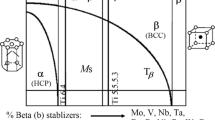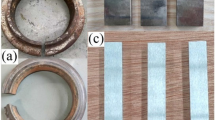Abstract
An investigation was undertaken to seek the grinding characteristics in the grinding of boron-diffusion-hardened TC21-DT titanium alloy using a vitrified CBN wheel. The grinding forces and temperature were measured and the morphological properties of ground surfaces were examined. The results indicated that, for conventional speed grinding, material removal was mainly dominated by ploughing coupled with somewhat shearing. For the high-speed grinding process, due to the different mechanical properties between titanium substrate and hard phase particles, the strain gradient effect in the primary deformation zone (PDZ) appeared to arise. Moreover, when the grinding speed was increased to 120 m/s, chip formation by the shearing process was accounted for a positive role, resulting in a considerable improvement in the ground surface roughness. In addition, the modeling of the specific grinding energy in the PDZ, during the grinding process, was provided, and the general trend predicted by the model was found to be the same as that investigated by experimental results.
Similar content being viewed by others
References
Ataibis V, Taktak S (2015) Characteristics and growth kinetics of plasma paste borided Cp-Ti and Ti6Al4V alloy. Surf Coat Tech 27:965–71
Xu XP, Yu YQ, Huang H (2003) Mechanisms of abrasive wear in the grinding of titanium (TC4) and nickel (K417) alloys. Wear 255:1421–1426
Sarma B, Tikekar NM, Ravi Chandran KS (2012) Kinetics of growth of superhard boride layers during solid state diffusion of boron into titanium. Ceram Int 386:795–6785
Zhu YS, Lu WZ, Zuo DW, Sun YL, Wang H, Xu J (2014) Effects of rare earth additions during surface boriding on microstructure and properties of titanium alloy TC21. Mater Sci Technol 30(14):1765–1769
Zhu YS, Lu WZ, Zuo DW, Feng W, He YF (2014) Microstructure and tribological properties of REs borided TC21 alloy. Sur Eng 30(8):612–618
Gawroński Z, Kruszyński B, Kula P (2005) Synergistic effects of thermo-chemical treatment and super abrasive grinding in gears’ manufacturing. J Mater Process Technol 159:249–256
Setti D, Sinha MK, Ghosh S, Rao PV (2015) Performance evaluation of Ti-6Al-4V grinding using chip formation and coefficient of friction under the influence of nanofluids. Int J Mach Tools Manuf 88:237–248
Jackson MJ, Hitchiner MP (2011) Machining with abrasives: abrasive tools and bonding systems. Springer, US
Li X, Chen ZT, Chen WY (2011) Suppression of surface burn in grinding of titanium alloy TC4 using a self-inhaling internal cooling wheel. Chinese J Aeronaut 24:96–101
Kopac J, Krajnik P (2006) High-performance grinding—a review. J Mater Process Technol 175:278–284
Xu J, Lu WZ, Wang H, Zhu YS, Huang QC, Zuo DW (2014) Characteristics and wear properties of grinding surface of titanium alloy TC4-DT. Acta Aeronaut Astronaut Sin 25:567–573
Zhao B, Ding WF, Dai JB, Xi XX, Xu JH (2014) A comparison between conventional speed grinding and super-high speed grinding of (TiCp+TiBw)/Ti-6Al-4V composites using vitrified CBN wheel. Int J Adv Manuf Technol 72:69–75
Shi ZF, Guo HZ, Liu R, Wang XC, Yao ZK (2015) Microstructure and mechanical properties of TC21 titanium alloy by near-isothermal forging. T Nonferr Metal Soc 25:72–79
Zhao YQ, Hong Q, Ge P (2011) Metallographic atlas of titanium and titanium alloys (in Chinese). Central South University press, Changsha, pp 65–70
Joshi SS, Melkote SN (2004) An explanation for the size-effect in machining using strain gradient plasticity. J Manuf Sci E 126:679–684
Tian L, Fu YC, Xu JH, Li HY, Ding WF (2015) The influence of speed on material removal mechanism in high speed grinding with single grit. Int J Mach Tools Manuf 89:192–201
Nazari A (2011) Strain gradient plasticity theory for modeling JIC of functionally graded steels. Comp Mater Sci 50:3403–3409
Liang HQ, Guo HZ, Ning YQ, Yao ZK, Zhao ZL (2014) Analysis on the constitutive relationship of TC18 titanium alloy based on the softening mechanism. Acta Metall Sin 50:871–878
Ashby MF (1970) The deformation of plastically non-homogeneous materials. Philos Mag 21:399–424
Huang Y, Zhang F, Hwang KC, Nix WD, Pharr GM, Feng G (2006) A model of size effects in nano-indentation. J Mech Phy Solids 54:1668–1686
Ding WF, Zhao B, Xu JH, Yang CY, Fu YC, Su HH (2007) Grinding behavior and surface appearance of (TiCp+TiBw)/Ti-6Al-4V titanium matrix composites. Chinese J Aeronaut 27(5):1334–1342
Author information
Authors and Affiliations
Corresponding author
Rights and permissions
About this article
Cite this article
Zhu, Y., Lu, W., Sun, Y. et al. Grinding characteristics in high-speed grinding of boron-diffusion-hardened TC21-DT titanium alloy with vitrified CBN wheel. Int J Adv Manuf Technol 89, 1269–1277 (2017). https://doi.org/10.1007/s00170-016-9193-0
Received:
Accepted:
Published:
Issue Date:
DOI: https://doi.org/10.1007/s00170-016-9193-0




